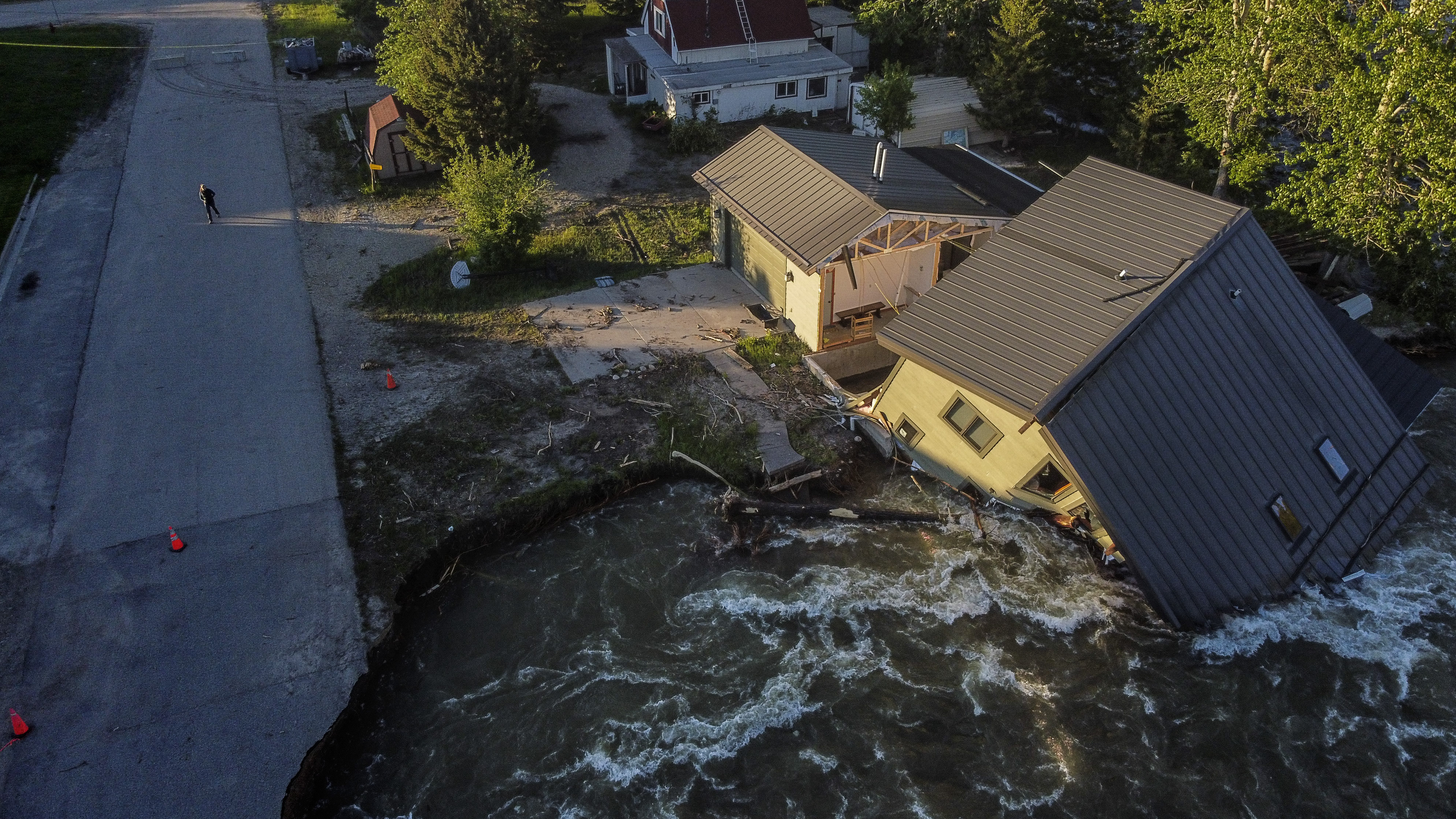How Dangerous Climate Whiplash Is Reshaping Our Cities

Table of Contents
Infrastructure Vulnerability to Climate Whiplash
Climate whiplash relentlessly attacks our cities' infrastructure, causing widespread damage and disruption. The unpredictable nature of these events overwhelms systems designed for more predictable weather patterns, leading to substantial financial and societal costs.
Damage to Transportation Networks
The erratic shifts in temperature and precipitation directly impact our transportation networks.
- Increased potholes: Freeze-thaw cycles, exacerbated by climate whiplash, cause significant damage to roads, leading to a proliferation of potholes and increasing maintenance costs.
- Bridge collapses: Intense rainfall and flooding can compromise the structural integrity of bridges, leading to potential collapses and crippling transportation disruptions.
- Public transport disruptions: Extreme heat can cause railway lines to buckle, while storms can damage overhead power lines, significantly impacting public transportation reliability.
A recent study by the American Society of Civil Engineers estimated that climate whiplash-related infrastructure damage costs the US billions of dollars annually, highlighting the urgent need for adaptation.
Water Management Systems Under Strain
Climate whiplash creates a double-edged sword for water management systems.
- Overburdened drainage systems: Intense rainfall following periods of drought overwhelms drainage systems, leading to widespread flooding and sewer backups. This can contaminate water supplies and pose serious public health risks.
- Water shortages: Prolonged droughts, a common feature of climate whiplash patterns, deplete reservoirs and groundwater supplies, leading to water scarcity and restrictions. This is further exacerbated by the rapid runoff of intense rainfall, which limits the capacity of water systems to capture and store water.
The implications for water security and public health are severe, demanding investment in more resilient and adaptable water management systems.
Energy Grid Instability
The unpredictable nature of climate whiplash poses significant challenges for energy grids.
- Power outages: Extreme heat can overload power grids, causing widespread blackouts, while severe storms can damage power lines and transmission infrastructure.
- Disruptions to renewable energy sources: Unpredictable weather patterns impact the reliability of renewable energy sources like solar and wind power, making the energy supply even more vulnerable.
The economic consequences of power outages resulting from climate whiplash are substantial, impacting businesses, hospitals, and essential services. Investing in grid modernization and incorporating more resilient energy sources are crucial for mitigating these risks.
Public Health Impacts of Climate Whiplash
The unpredictable shifts in weather patterns associated with climate whiplash pose significant threats to public health, exacerbating existing health inequalities and creating new challenges.
Increased Heat-Related Illnesses
Rapid temperature fluctuations, a hallmark of climate whiplash, increase the risk of heat-related illnesses.
- Heatstroke: Extreme heatwaves can lead to heatstroke, a life-threatening condition.
- Dehydration: Fluctuating temperatures increase the risk of dehydration, particularly among vulnerable populations.
- Exacerbated cardiovascular problems: Heat stress can significantly worsen existing cardiovascular problems.
The elderly, children, and low-income communities are disproportionately affected by heat-related illnesses.
Spread of Infectious Diseases
Extreme weather events associated with climate whiplash can facilitate the spread of infectious diseases.
- Waterborne diseases: Flooding contaminates water sources, increasing the risk of waterborne diseases such as cholera and typhoid fever.
- Increased vector-borne diseases: Changes in temperature and rainfall patterns can expand the range of disease vectors like mosquitoes, leading to an increased incidence of malaria, dengue fever, and other vector-borne illnesses.
Effective disease prevention and control strategies are crucial for mitigating these public health risks during unpredictable weather patterns.
Mental Health Impacts
The repeated exposure to extreme weather events and the uncertainty associated with climate whiplash can have profound mental health consequences.
- Anxiety and depression: The constant threat of extreme weather events can lead to increased anxiety and depression.
- Post-traumatic stress disorder (PTSD): Experiencing the devastation of a climate whiplash event can trigger PTSD.
Access to mental health support services is critical for individuals affected by the psychological toll of climate whiplash.
Adapting Cities to Climate Whiplash
Building resilient cities requires a multifaceted approach that integrates infrastructure improvements, enhanced preparedness, and sustainable urban planning.
Resilient Infrastructure Design
Investing in resilient infrastructure is crucial for mitigating the impacts of climate whiplash.
- Green infrastructure solutions: Incorporating green spaces, permeable pavements, and green roofs can help manage stormwater runoff and reduce the risk of flooding.
- Improved drainage systems: Upgrading drainage systems to handle intense rainfall is essential.
- Resilient building materials: Using building materials that can withstand extreme weather events is paramount.
Early Warning Systems and Emergency Preparedness
Effective early warning systems and preparedness plans are vital for minimizing the damage and loss of life caused by climate whiplash events.
- Improved weather forecasting: Investing in advanced weather forecasting technologies is essential for providing timely warnings.
- Community-based early warning systems: Engaging communities in early warning systems can ensure effective response and evacuation strategies.
- Emergency response plans: Developing comprehensive emergency response plans for various extreme weather scenarios is crucial.
Sustainable Urban Planning
Sustainable urban planning plays a crucial role in mitigating the impacts of climate whiplash.
- Urban green spaces: Increasing green spaces within cities can help regulate temperatures, absorb stormwater, and improve air quality.
- Permeable pavements: Using permeable pavements allows rainwater to seep into the ground, reducing surface runoff and the risk of flooding.
- Sustainable water management practices: Implementing sustainable water management practices, such as rainwater harvesting and water reuse, is essential for ensuring water security.
Conclusion
Climate whiplash is dramatically reshaping our cities, causing widespread damage to infrastructure, posing significant public health risks, and creating immense psychological stress. The interconnectedness of these challenges necessitates a holistic and proactive approach. We must invest in resilient infrastructure design, implement effective early warning systems, and adopt sustainable urban planning practices to mitigate the devastating effects of climate whiplash. Understanding climate whiplash and its profound impact is not just about adaptation; it's about building safer, healthier, and more sustainable communities for the future. Learn more about climate whiplash in your city and engage with local authorities and organizations working on climate adaptation strategies. Let's work together to build resilient communities and mitigate the impact of this dangerous phenomenon. The future of our cities depends on it.

Featured Posts
-
 Ryan Reynolds Faces Backlash Justin Baldonis Lawyer Refuses To Drop Lawsuit
May 28, 2025
Ryan Reynolds Faces Backlash Justin Baldonis Lawyer Refuses To Drop Lawsuit
May 28, 2025 -
 Veterans Day Victory Psv Clinches Eredivisie Title With Perisic And De Jong
May 28, 2025
Veterans Day Victory Psv Clinches Eredivisie Title With Perisic And De Jong
May 28, 2025 -
 Rome Champ Pushing Boundaries Maintaining Momentum
May 28, 2025
Rome Champ Pushing Boundaries Maintaining Momentum
May 28, 2025 -
 Cristiano Ronaldo 40 Yasinda Ve Durdurulamaz
May 28, 2025
Cristiano Ronaldo 40 Yasinda Ve Durdurulamaz
May 28, 2025 -
 Nintendos Bold New Era A Calculated Risk
May 28, 2025
Nintendos Bold New Era A Calculated Risk
May 28, 2025
Latest Posts
-
 Rolan Garos 2024 Grigor Dimitrov Se Zavrscha
May 31, 2025
Rolan Garos 2024 Grigor Dimitrov Se Zavrscha
May 31, 2025 -
 Racial Abuse Case Beautician Receives No Jail Time
May 31, 2025
Racial Abuse Case Beautician Receives No Jail Time
May 31, 2025 -
 Donald Trumps Overweight Friend Fact Or Fiction The Viral Story Explained
May 31, 2025
Donald Trumps Overweight Friend Fact Or Fiction The Viral Story Explained
May 31, 2025 -
 Beautician Escapes Prison For Repeated Racial Slurs Against Bouncer
May 31, 2025
Beautician Escapes Prison For Repeated Racial Slurs Against Bouncer
May 31, 2025 -
 White House Dismissed Elon Musks Plea To Stop Open Ai Uae Deal
May 31, 2025
White House Dismissed Elon Musks Plea To Stop Open Ai Uae Deal
May 31, 2025
